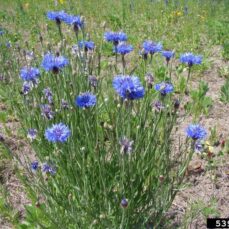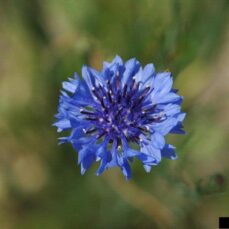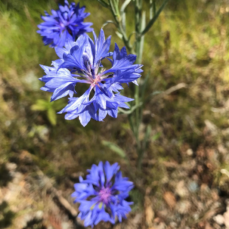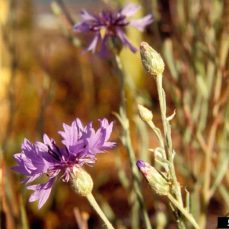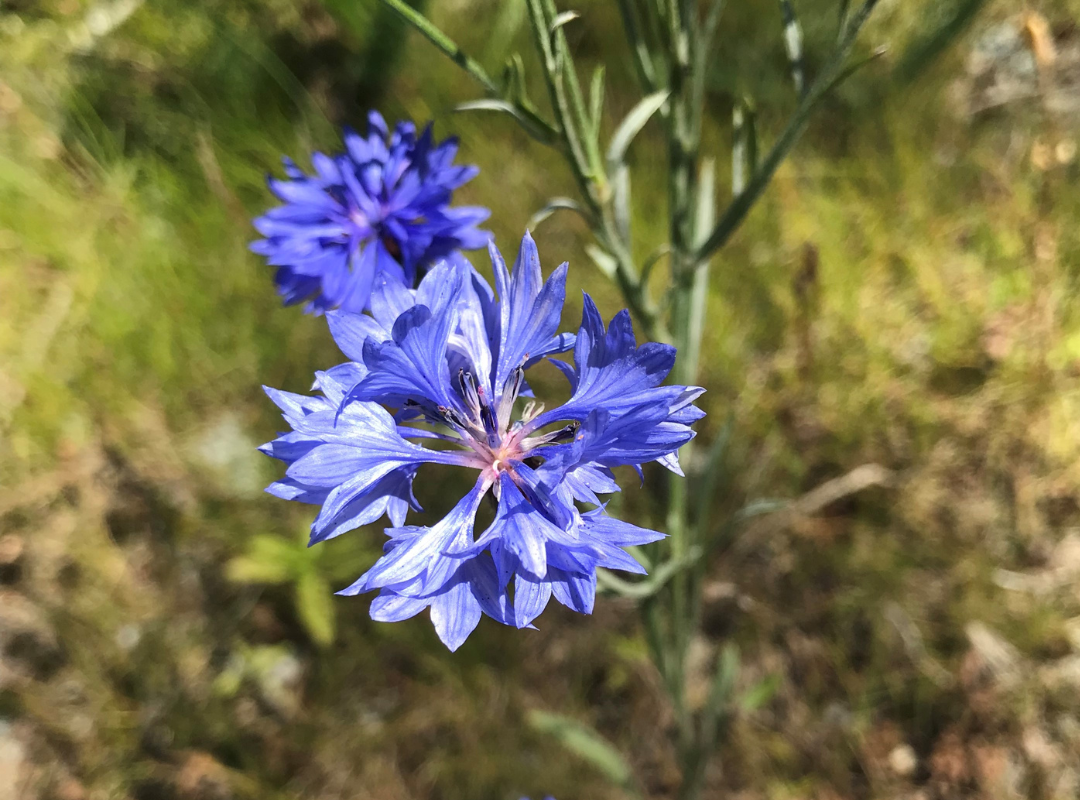
Management Category
Squamish
Whistler
Pemberton
Vectors of Spread
Synonyms
Cornflower, garden cornflower
ID Characteristics
General: Annual flowering plant in the daisy family (Asteraceae).
Flowers: Are pompom-like, with bracts at the base and fringed margins. They are typically greater than 3 cm wide. The marginal flowers are bell-shaped with enlarged irregular corollas. Flowers are typically blue, but can also be purple, pink, or white. Flowers are solitary at the end of a branched stem
Stem: Mature plants are 0.2 – 1.2 m tall. Stems are greyish-green, branched, erect, and loosely hairy.
Leaves: Are grey-green, matte, and lanceolate with narrow upper leaves and smooth edges. The lower leaves can be toothed or lobed along the margins. They can be up to 13 cm long and 1 cm wide.
Fruit: Are 4 – 5 mm long with fine, hairy bristles attached to one end. The seeds are typically straw-coloured.
Roots: Taproot.
Similar Species
Invasive
Mountain bluet (Centaurea montana) has thicker foliage and fewer flower petals.

Non-invasive
Cupid’s dart (Catananche caerulea) is a long-stalked flower with blue or purple jagged-edged flower heads.

Habitat and Origin
Bachelor’s button is native to Southern Europe where it is known as ‘cornflower’ and is commonly found in grain fields. It is now considered endangered in its native habitat.
Bachelor’s button prefers dry disturbed areas such as roadsides, riverbanks, meadows, fields, and grasslands.
How it Spreads
Bachelor’s button reproduces through seeds. The plant produces copious amounts of seeds, which germinate very quickly, helping the plant spread aggressively.
Bachelor’s button is spread by gardeners; it is often planted in gardens and is commonly found in wildflower seed mixes. It is also often found as a contaminant in crop seed. Moreover, seeds are spread by wind, water, and birds that eat the seeds.
Impacts
Ecological:
- Outcompetes native vegetation in meadows and grassland habitats.
- Decreases moisture and nutrients available in the soil.
Economic:
- Dense colonies invade grain fields and reduce crop yields.
- Seeds can contaminate crop seeds.
Prevent the Spread
Bachelor’s button is found in the Sea to Sky region and its distribution is beyond landscape-level control. When bachelor’s button is present at high-priority locations and negatively impacting them, their control is considered a high priority.
Otherwise, the goal is to prevent it from spreading to new (uninfested) areas, and to control it where possible to limit its impact on biodiversity.
Learn to identify bachelor’s button: use the images presented in this profile page to learn how to identify bachelor’s button.
What to do if you spot it: You can report any bachelor’s button sighting by visiting our reporting page.
DO:
- Regularly monitor properties for weed infestations.
- Ensure soil and gravel are uncontaminated before transport.
- Check wildflower mixes to ensure that they do not contain bachelor’s button.
- Ensure that plants are disposed of in a garbage bag if found in floral arrangements to prevent seeds from spreading.
DO NOT:
- Do not unload, park or store equipment or vehicles in infested areas; remove plant material from any equipment, vehicles, or clothing used in such areas and wash equipment and vehicles at designated cleaning sites before leaving infested areas.
- Do not plant bachelor’s button in a garden, no matter how well-contained its enclosure may seem.
- Do not move soil that has been contaminated with bachelor’s button.
- Do not compost
Control
Mechanical
- Repeated hand-pulling is the most effective way to control bachelor’s button, as long as the entire root system is removed.
- Regular mowing or tilling can reduce weed progression; material can be left on-site to decompose if the plant has not started flowering yet.
- Once bachelor’s button has flowered, all plant parts must be bagged and deeply buried at the landfill.
- Deadheading (removing the spent flower heads) can limit the plant’s self-seeding tendencies.
- When tilling, be sure to prevent machinery from spreading root fragments to new sites by washing it.
Chemical
- Plants should be treated when they are in the rosette stage.
- Bachelor’s button control has shown success when using a mixture of glyphosate and aminopyralid or glyphosate and clopyralid.
We recommend that any herbicide application is carried out by a person holding a valid BC Pesticide Applicator Certificate. Before selecting and applying herbicides, you must review and follow herbicide labels and application rates; municipal, regional, provincial and federal laws and regulations; species-specific treatment recommendations, and site-specific goals and objectives.
Biological
There are no biological control agents currently available for this plant.
Sea to Sky Distribution
Bachelor’s Button Factsheet
Having trouble viewing the factsheet? Don’t worry, all the information is included on this page. You can also contact us with any questions.
References
- Canadian Council on Invasive Species, Canada’s Unwanted Invasive Plants (2019)
- E-Flora BC, Centaurea cyanus
- Invasive Plant Atlas, Cornflower
- Invasive Species Council of BC, Bachelor’s Button
- Missouri Botanical Garden, Centaurea cyanus
- North Carolina State Extension Gardener Plant Toolbox, Centaurea cyanus
- Pacific Northwest Pest Management Handbooks, Centaurea cyanus (Bachelor’s Button)-Downy Mildew
- Tennessee Invasive Plant Council, Centaurea cyanus
- Washington State Noxious Weed Control Board, Bachelor’s Buttons
- Wikipedia, Centaurea cyanus





